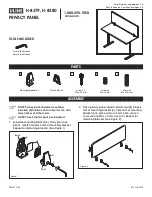
Manual Mode Displays
The manual mode displays are intended to provide the unit with a reasonable capability for
demonstrating the properties of the unit, and are also useful for testing This capability may also be
sufficient to complete simple effect installations where the cost or complexity of DMX controls are
not necessary, but the benefits of a compact and very low maintenance UV source would be
attractive. For those installations where the manual mode capacity of the unit are not precise or
flexible enough, the use of the DMX control features should allow the unit to perform exactly as
required.
Manual Mode Operation
Manual Mode operation is available only when the internal Mode jumpers in the unit are set to
Mode 1, and the DMX address switches on the unit are set to addresses 600 and higher, which are
beyond the normal range of the DMX-512 standard of 512 channels. The address switch settings in
the range of from 600 to 699 and from 700 to 799 correspond to distinct manual mode functions as
described in the following table:
Manual Mode
Minimum
Maximum
Minimum Effect
Maximum Effect
Intensity
600
699
0%
100%
Strobe
700
799
.5 Hz.
30 Hz.
Manual Display Programming
Operation of the unit in Manual Mode is controlled by the settings of the DMX address switches.
The output of the unit may be adjusted using the address switch settings to obtain a wide range of
intensity levels and strobe rates. Once established, manual mode settings are retained when power
is removed from the unit, and will be restored when power is reapplied provided that no changes are
made to the address switch settings. The manual settings may be altered by adjusting the settings at
any time. The unit will resume normal DMX operations when the address switches are set to a
value of 512 or less.
Manual Mode Intensity Control
When the base address switches are set to a range of 600 to 699 when power is first applied to the
unit, the unit will produce UV output from 0 to 100 percent intensity, with no output at a setting of
600, and maximum output at a setting of 699. Output within this range is continuous, and is not
affected by any other setting.
Manual Mode Strobe Rate Control
When the base address switches are set to a range of 700 to 799 when power is first applied to the
unit, the unit will produce strobed UV output at 100 percent intensity, with a minimum rate of .1
Hz. (5 seconds on, 5 seconds off) at a setting of 700, and a maximum rate of approximately 30 Hz.
at a setting of 799. Control settings above this level will result in continuous output.






























